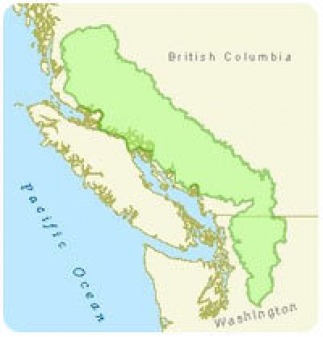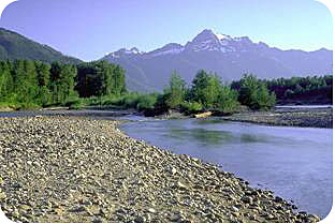Pacific Ranges Ecoregion
Over the past few weeks I have been reasearching and studying the Canadian ecoregion called, "Pacific Ranges". This ecoregion is part of the Pacific Maritimes ecozone located on the mainland coast of British columbia all the way through to the Northern tip of Washington state. It measures 46,500 square miles and has elevations up to 4000 meters above sea level. The annual temp varies from year to year but the mean annual temperature of the area at this current time is 6.5 degrees celsius. Pacific Ranges covers area from the coast (windward side of mountains) all the way over the coastal mountains to the leeward side, it is considered a temperate coniferous forest in this area. This affects the measure of parcipitation in the region (between 1,520 mm. to 4,060mm. per year). Pacific Ranges is also a marine climate (also affecting precipitation), and with that fact and it's position in relativeness to latitude creates miniature ecosections withing the ecoregion. There are four basic ecosections within the ecoregion they are:
1. Eastern Pacific Ranges Ecosection - inland area, rainshadow with transitional climate, rugged area
2. Northern Pacific Ranges Ecosection - ice-capped mountains, glaciers, steep and rugged, located in the North
3. Outer Fiordland Ecosection - low relief, rugged, made up of islands, penninsulas, inlets, and fiords,holds most of ecoregion's water supply
4. Southern Pacific Ranges Ecosection - high rainfall, very steep mountains, closer to ocean side (windward side)
Pacific Ranges land is mostly undevelpoed and left untouched by humans, the main human contact made in the Pacific Ranges is the large ski resort at Whistler and the many logging companies that occupy the region. About 40 percent of land is left for wildlife while the other 60 percent is shared by both humans and animals. Many different animals live in this region including; black tailed deer, black bear, grizzly beat, mountain goat, mink, Northern river otter, blue grouse, hundreds of types of marsh land birds, moose, woodland caribou, beaver, red fox, cougars, wolves,marten, snowshoe hare,etc. Also there is hundreds of different types of marine animals including killer whales, many types of fish, seals, walrus, sea lions, etc. Pacific Ranges also has a form of black bear that has a variation of fur colour often appearing white, they are called "Spirit Bears" by the locals. Pacific Ranges is a complex and extraordinary region and as you tour through my website you will discover all of the amazing facts about it !
1. Eastern Pacific Ranges Ecosection - inland area, rainshadow with transitional climate, rugged area
2. Northern Pacific Ranges Ecosection - ice-capped mountains, glaciers, steep and rugged, located in the North
3. Outer Fiordland Ecosection - low relief, rugged, made up of islands, penninsulas, inlets, and fiords,holds most of ecoregion's water supply
4. Southern Pacific Ranges Ecosection - high rainfall, very steep mountains, closer to ocean side (windward side)
Pacific Ranges land is mostly undevelpoed and left untouched by humans, the main human contact made in the Pacific Ranges is the large ski resort at Whistler and the many logging companies that occupy the region. About 40 percent of land is left for wildlife while the other 60 percent is shared by both humans and animals. Many different animals live in this region including; black tailed deer, black bear, grizzly beat, mountain goat, mink, Northern river otter, blue grouse, hundreds of types of marsh land birds, moose, woodland caribou, beaver, red fox, cougars, wolves,marten, snowshoe hare,etc. Also there is hundreds of different types of marine animals including killer whales, many types of fish, seals, walrus, sea lions, etc. Pacific Ranges also has a form of black bear that has a variation of fur colour often appearing white, they are called "Spirit Bears" by the locals. Pacific Ranges is a complex and extraordinary region and as you tour through my website you will discover all of the amazing facts about it !


